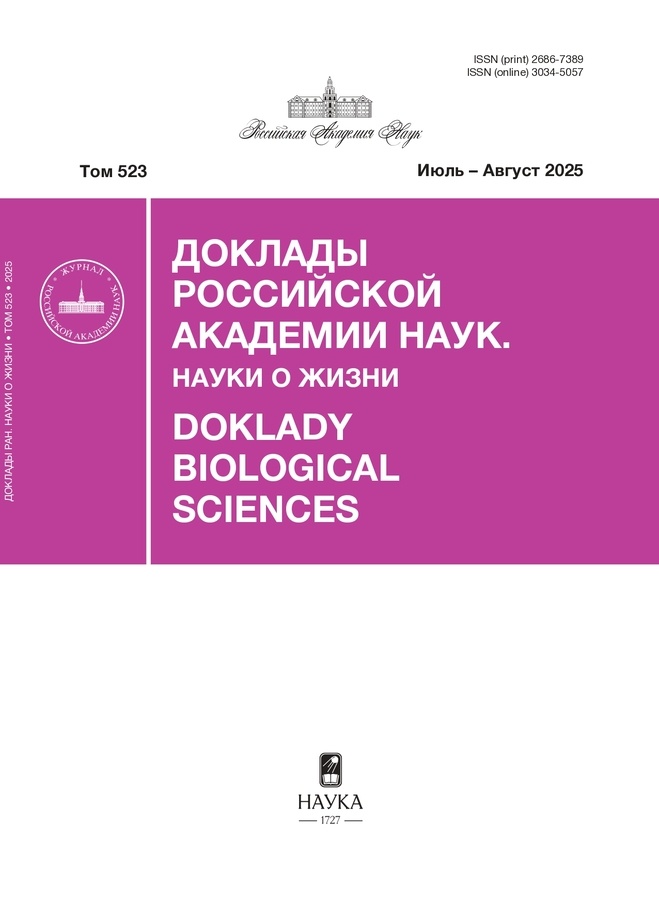Прижизненный оптический биоимиджинг при раке яичника с использованием люминесцирующей клеточной линии
- Авторы: Шрамова Е.И.1, Прошкина Г.М.1, Деев С.М.1,2,3
-
Учреждения:
- Федеральное государственное бюджетное учреждение науки Государственный научный центр Российской Федерации Институт биоорганической химии им. академиков М.М. Шемякина и Ю.А. Овчинникова Российской академии наук
- Национальный исследовательский центр “Курчатовский Институт”
- Казанский федеральный университет
- Выпуск: Том 522, № 1 (2025)
- Страницы: 345-350
- Раздел: Статьи
- URL: https://kazanmedjournal.ru/2686-7389/article/view/686375
- DOI: https://doi.org/10.31857/S2686738925030058
- ID: 686375
Цитировать
Полный текст
Аннотация
Метод прижизненного биоимиджинга на основе люминесценции занимает важное место в разработке и тестировании противоопухолевых препаратов на модельных животных и является неотъемлемой частью доклинических исследований. Биоимиджинг на основе люминесцентных систем, по сравнению с флуоресцентным биоимиджингом, обеспечивает высокое соотношение сигнал/шум, что обосновывает разработку клеточных линий, стабильно экспрессирующих ген люциферазы, для последующего использования на модельных животных. В работе описано создание клеточной линии SKOV3.ip1-NanoLuc, конститутивно экспрессирующей ген люциферазы NanoLuc. Показано эффективное применение разработанной клеточной линии для прижизненного люминесцентного биоимидижинга глубинных опухолей у иммунодефицитных животных с моделями поздних стадий рака яичника.
Ключевые слова
Полный текст
Об авторах
Е. И. Шрамова
Федеральное государственное бюджетное учреждение науки Государственный научный центр Российской Федерации Институт биоорганической химии им. академиков М.М. Шемякина и Ю.А. Овчинникова Российской академии наук
Автор, ответственный за переписку.
Email: shramova.e.i@gmail.com
Россия, Москва
Г. М. Прошкина
Федеральное государственное бюджетное учреждение науки Государственный научный центр Российской Федерации Институт биоорганической химии им. академиков М.М. Шемякина и Ю.А. Овчинникова Российской академии наук
Email: shramova.e.i@gmail.com
Россия, Москва
С. М. Деев
Федеральное государственное бюджетное учреждение науки Государственный научный центр Российской Федерации Институт биоорганической химии им. академиков М.М. Шемякина и Ю.А. Овчинникова Российской академии наук; Национальный исследовательский центр “Курчатовский Институт”; Казанский федеральный университет
Email: shramova.e.i@gmail.com
академик РАН, Научно-исследовательская лаборатория “Биомаркер”, Институт фундаментальной медицины и биологии
Россия, Москва; Москва; КазаньСписок литературы
- Tuguntaev R.G., Hussain A., Fu C., et al. Bioimaging guided pharmaceutical evaluations of nanomedicines for clinical translations // J Nanobiotechnol. 2022. Vol. 20. P. 236.
- Yu D., Wolf J.K., Scanlon M., et al. Enhanced c-erbB-2/neu expression in human ovarian cancer cells correlates with more severe malignancy that can be suppressed by E1A // Cancer Res. 1993. Vol. 53, №4. P. 891–898.
- Galogre M., Rodin D., Pyatnitskiy M., et al. A review of HER2 overexpression and somatic mutations in cancers // Critical Reviews in Oncology/Hematology. 2023. Vol. 186. P. 103997.
- Hall M.P., Unch J., Binkowski B.F., et al. Engineered luciferase reporter from a deep sea shrimp utilizing a novel imidazopyrazinone substrate // ACS Chem Biol. 2012. Vol. 7. №11 P. 1848–57.
- Shramova E.I., Chumakov S.P., Shipunova, V.O., et al. Genetically encoded BRET-activated photodynamic therapy for the treatment of deep-seated tumors // Light Sci Appl. 2022. Vol. 11. P. 38.
- Deyev S., Proshkina G., Baryshnikova O., et al. Selective staining and eradication of cancer cells by protein-carrying DARPin-functionalized liposomes // European Journal of Pharmaceutics and Biopharmaceutics. 2018. Vol. 130. P. 296–305.
- Taylor A., Sharkey J., Plagge A., et al. Multicolour in vivo bioluminescence imaging using a NanoLuc-based BRET reporter in combination with firefly luciferase // Contrast Media & Molecular Imaging. 2018. P. 2514796.
- Ogawa M., Takakura H. Optical-based detection in live animals. In: Tanaka K., Vong K., editors. Handbook of in vivo chemistry in mice. Wiley‐VCH Verlag GmbH & Co. KgaA. 2020. P. 55–101.
- Sokolova E.A., Shilova O.N., Kiseleva D.V., et al. HER2-specific targeted toxin DARPin-LoPE: immunogenicity and antitumor effect on intraperitoneal ovarian cancer xenograft model // Int. J. Mol. Sci. 2019. Vol. 20. № 10. P. 2399.
Дополнительные файлы













